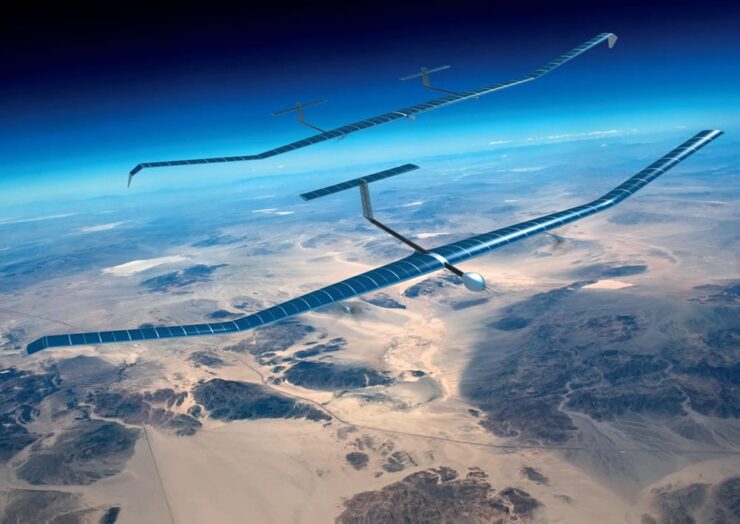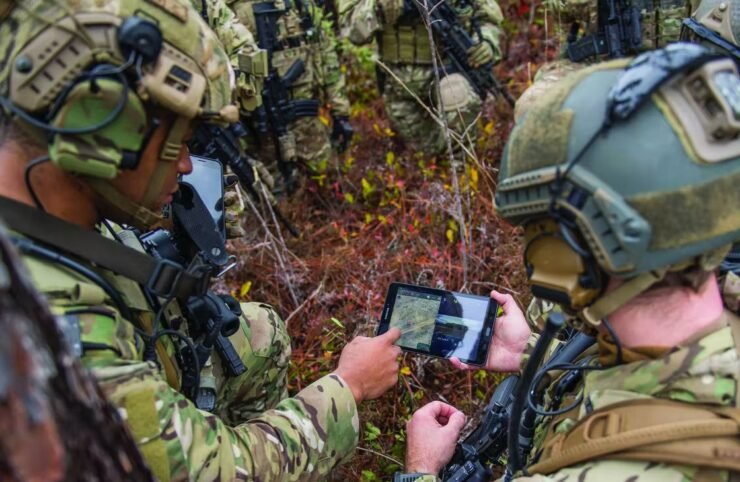
Gulf War-1 in January & February 1991saw extensive use of tank and air power that swiftly pushed back Iraqi invasion forces from Kuwait and took the war into Iraq. Prior to the launch of actual ground assault into Kuwait, Naval and Air bombardment for five weeks was carried out. The swiftness of liberation of Kuwait and pushing back Iraqi forces back, their pursuit and destruction in just 100 hours from beginning of ground campaign came as a surprise to many US Military Commanders. The concept of “Shock and Awe” was once again employed during the Iraqi Freedom and Enduring Freedom. A common criterion for all these was networked operations. The binding glue was robust communication networks that that operationally interconnected and integrated all assets in a battlefield. Iraq war saw extensive use of Commercially off the Shelf (COTS) Cisco Defence Solution equipment.
However, despite launching 17 low orbit satellites and numerous communication UAVs, report of US Congress Committee on Defence highlighted the scarcity in bandwidth in tactical battle area. The use of commercial ERPs and Messaging / video conferencing, that had excellent & unmatched look and feel failed military zeal.
ICT infrastructure (Info-structure) in Tactical Battle Area (TBA) would always be at a premium. Since 2005, there has been quantum jump in tactical communication systems. Iraq and Afghanistan underscored the need to shift to Satellite and Beyond Line Of Sight communications. Military exploitation of 5G in TBA is awaiting successful trials and validation by US DoD. Release 17 and 18 of 5G incorporates HAPS/ UAVs and Satellite in 5G infrastructure. A C4I2SRcommunication grid will be a heterogenous mix of fibre-based NGN, wireless, IMT, MANET and satellite based high-capacity networks. ICT will be predominantly cloud based, with cloud in a box that can be deployed in TBA. AI engines would carry out Machine Learning, Deep Learning, Neural Networks, computer vision and other AI functions at the edge as well as in the cloud.
Omni presence of ICT and AI info-structure can only be assured by constellation of defence and civil satellites and High Altitude Aerial Platforms (HAPS, commonly referred to as High Altitude Pseudo-Satellites). HAPS could be of long duration with solar powered UAVs flying at altitudes of 23 Kms
Omni presence of ICT and AI info-structure can only be assured by constellation of defence and civil satellites and High Altitude Aerial Platforms (HAPS, commonly referred to as High Altitude Pseudo-Satellites). HAPS could be of long duration with solar powered UAVs flying at altitudes of 23 Kms; where atmospheric turbulence is least, tethered drones or UAVs with communication payloads with endurance of 8 to 10 hours. All UAVs may not have ISR payloads but all without exception will have communication modules. Ab-initio equipping all UAVs/ HAPS with a capability to form an Aerial Data Network would be a wise choice to meet the network requirements of space exploitation.
Communications were the entry key to Network-centric warfare (NCW), now more than ever before they are bedrock of AI, Intelligence, surveillance and reconnaissance (ISR) and digital battlefield.
Road to Space
It is heartening to see that ISRO and many Indian Industries have enhanced the satellite launch capacity of Indian scape industry. In 2015, I recall ISRO was launching just about 10 to 12 satellites in a year. In a meeting to set a roadmap for ISRO and Indian Space agencies in 2015, Dy NSA expressed concern of losing out to China in winning satellite related projects of SAARC Nations. He conveyed the direction of PMO to double their capacity within one year.
Rapid advancement in computer and communication technology has ushered in highly advanced, long range and precision weapons for interdiction. Armenian and Azerbaijan war of 2020, also known as “War of Drones” saw significant territorial gains made by Azerbaijan
On 14 Feb 2017, ISRO set an unbeaten world record of putting 104 satellites in orbit in one Polar Satellite Launch Vehicle.This capability has great strategic significance. India can now launch small and medium defence satellites at mobilisation stage of war or at preparatory stage. Of course, the concept of ready to launch mothballing of satellite systems must be brought into Mob Schemes. The experts in Defence Satellite Agency need to look at this technical and operational aspect. Just a constellation of four or five Defence Satellites will be inadequate in capacity and most importantly will be brought down within 48 hours by PLA’s anti-satellite system. The path to putting multiple satellites in orbit is well treaded and sure. National Technical Research Organisation (NTRO) and security agencies need to develop ELINT, ISR, Imagery, EW, Communication, payloads that can be incorporated into a satellite system and operationalised and made available to the end users on outbreak of hostilities. The Defence Space Agency (DSA) needs to work out the quantum of satellite infrastructure that is ab initio available 24×7. Additional satellites that would need to be assembled, payloads integrated and launched during M-period (Mobilisation) need fine-tuning and war gammed. To avoid wastage of life span of space assets and ensure adequate quantum is available at the time of need all stakeholders need to work in unison to make small satellites and HAPS operationally viable.
Paradigms of Space Exploitation
Interdiction of enemy assets and forces is an ever prevalent and age-old concept. Rapid advancement in computer and communication technology has ushered in highly advanced, long range and precision weapons for interdiction. Armenian and Azerbaijan war of 2020, also known as “War of Drones” saw significant territorial gains made by Azerbaijan. Armoured artillery and drones proved to be a lethal war winning factor.

Again, in the ongoing Ukraine invasion, effective use of drones, precision artillery weapons has slowed the Russian advance. Precision Artillery with drones and loitering ammunition were highly effective in destroying Russian tanks. Precision Artillery continues to be a war winning factor and Gods of War. The space-based intelligence provided by USA to Ukraine has resulted in eliminating and targeting the Russian top brass and chain of command.Proxy war by USA and its allies by ensuring unending military hardware supply to Ukraine has made it impossible for Russia to disrupt the supply chain. The result is Russia has not been able to ensure air superiority over Ukraine due to thousands of shoulder-fired anti-aircraft missiles. Their threat to treat any supply of military hardware to Ukraine as an act of war against Russia too has not; and is unlikely to yield any tangible military gains. ISR, Drones, Precision weapons, and space based ISR assets can be very effective even against an advanced and numerically superior adversary.
Indian Requirements
India has always had a well thought out and structured force development. ACCCS, Project Shakti integrated all medium range arty assets and improved their efficacy and effectiveness (Use of networked and integrated Arty was the main cause of destruction of Russian armour and halting their advance). Indian military has always been cash-strapped and accordingly integration of Arty was done for field and medium arty. Long-range arty was to be integrated in next stage with incorporation of UAVs / Drones for DOAF (Direction of Own Arty Fire) and PSDA (Post Strike Damage Assessment). Loitering Ammunition, precision guided munition, kamikaze drones are on the anvil. Way back in 2002-04 concept of UAVs as ISR, communication, ELINT, EW platforms was formalised. The bird was designed to carry payloads based upon the operational requirements. Scaling too was done. Unfortunately, more pressing defence acquisition pushed these south wards in the priority list. Hopefully, lessons from the modern wars in Eastern Europe will put the spotlight back on not only these projects but will also give right impetus to C4I2SR.
In the ongoing Ukraine invasion, effective use of drones, precision artillery weapons has slowed the Russian advance. Precision Artillery with drones and loitering ammunition were highly effective in destroying Russian tanks
Tac C3I systems and C4I2SR assets need to be interconnected in terms of information sharing and direct tasking by commanders at all levels. The one & only guiding principle should be the reach, capability and hand-over of potential threats from strategic distance to long, intermediate and tactical distances. Exclusive ownership of space and other national assets can no longer yield desired operational results. Fusion of assets will avoid confusion. The end users are the assets on ground (battle space) and they need these inputs to neutralise the threat effectively and efficiently.
Government Initiatives
Again, concept of integrated battle field is not a totally new concept. It evolves with operational necessity. In slower paced battle of the past, Tac HQs, LOs exchanged / placed at formation. HQs, GLOs, TAC, FAC etc were sufficient and could cope with the pace of the battle. This is no longer suited for modern day digital battlefield. Integrated Theatre Battles are being put in place. Integrated air defence, maritime defence and ground battle need to share and support each other to optimise success. Land, sea and space and the nation’s territory need to be kept under constant surveillance and furiously protected. If in future the territories extend to moon / mars and need to be protected, India must not hesitate to lay her claim. The Chandryan and Mars missions are a step in staking India’s rightful claim over these in future.
Drones, AI, Cyber and ICT are being given considerable impetus under “Aatmanerbhar Bharat” and self-reliance in defence production. Ensuring global presence in production is a foolproof method to ensure maintenance of supply chain during war. Innovation for defence excellence, incorporation of IITs and start-ups in defence innovation are likely to offer big opportunities to Indian industries. Indigenous manufacture of electronic components/ modules, wafers, ICs and microprocessors will enhance India’s capabilities many folds.
The GoI, however, needs to offer protection, in terms of high production cost of defence equipment. The production line must be utilisable for subsequent orders. Current DAP 2020 offers no guarantee of repeat orders. DPSUs can absorb the brunt of limited production. DRDO as Development Agency offers their design first to DPSUs; hence DPSUs have additional edge over private Indian player in terms of reduced R&D cost. It needs to be appropriately modified to get expertise of private industry skill sets.
Convergence of Technology Providers and End-users
Recent wars have amply demonstrated the strategic and military ascendency provided by UAVs, RPVs, HAPS, satellites and other space and aerial assets. Video and imagery are far superior modes of ISR that blips on radar-screens earphones. AI techniques, primarily Computer Vision offers accurate and non-repudiation ISR inputs. Like all AI models, continuous data engineering and Evolutionary Data Analysis (EDA) is mandatory for sustained ML accuracy and sensitivity. AI is a golden opportunity for start-ups and will throw up many unicorns in defence related AI. The government and TSPs need to pitch in with a reliable and affordable AI infrastructure for Indian defence and security forces. Mehgraj is an excellent asset created by GoI that can be upgraded & updated and made available to AI start-ups. MCTE, Mhow has made considerable progress in the field of Military AI (Operational and logistics). AI is low hanging fruits that will yield unmatchable results. But, the only pitfall that I foresee is data hygiene and data handling practices. ML can’t learn unless it has a well-engineered data.
Only a collaborative approach by GoI, Major TSPs/ IT industries and start-ups will result in state-of-the-art AI and Space / HAPS/ Drones assets and unmatched capabilities.
– The author is a retired Indian Army officer from Signals. He has vast experience in design and rollout of ICT Communication Infrastructure both Strategic and Tactical. The views expressed are personal and do not necessarily reflect the views of Raksha Anirveda








